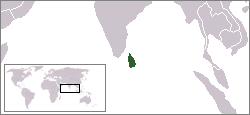
Back Massacre anti-tamouls (1958) French Massacre dos tâmeis no Ceilão em 1958 Portuguese 1958 ලංකා කෝලහාලය Singhalese 1958 இலங்கை இனக்கலவரம் Tamil
| 1958 anti-Tamil pogrom | |
|---|---|
 Location of Ceylon | |
| Location | Dominion of Ceylon |
| Date | May 22 – c. June 2, 1958 (+6 GMT) |
| Target | Primarily Tamils, also Sinhalese |
Attack type | Decapitation, burning, stabbing, shooting |
| Weapons | Knives, sticks, fire, guns |
| Deaths | 158 (official) to 1500[1][2][3] |
| Injured | 1,000+ |
| Perpetrators | Mostly Sinhalese mobs, also Tamil mobs |
The 1958 anti-Tamil pogrom and riots in Ceylon, also known as the 58 riots, refer to the first island-wide ethnic riots and pogrom[3][4][5] to target the minority Tamils in the Dominion of Ceylon after it became an independent dominion from Britain in 1948. The riots lasted from 22 May until 29 May 1958 although sporadic disturbances happened even after the declaration of emergency on 27 May 1958. The estimates of the murders[6] range, based on recovered bodies, from 158 to 1,500.[1][3] Although most of the victims were Tamils, Sinhalese and their property were also affected by retaliatory attacks by Tamil mobs throughout the Batticaloa and Jaffna districts.[7] As the first full-scale race riot in the country in over forty years, the events of 1958 shattered the trust the communities had in one another and led to further polarisation.
- ^ a b DeVotta p.118
- ^ "An evolving army and its role through time". The Sunday Times. 16 October 2005. Retrieved 29 October 2008.
The outbreak of island wide ethnic violence from May 24–27, 1958, saw for the first time the deployment of military personnel under emergency proclamations throughout the entire island, where Colombo and the North and East of the country witnessed the worst violence leading to over 300 deaths.
- ^ a b c "Genocide Against Tamil People: Massacres, Pogroms, Destruction of Property, Sexual Violence and Assassinations of Civil Society Leaders" (PDF). People's Tribunal on Sri Lanka (PTSL). Archived from the original (PDF) on 28 April 2016. Retrieved 8 May 2015.
- ^ Narratives of Gendered Dissent in South Asian Cinemas. New York: Routledge Publications. 2012. p. 126. ISBN 9780415961172.
- ^ Sivanandan, A. (July 1984). "Sri Lanka: racism and the politics of underdevelopment". Race & Class. 26 (1): 1–37. doi:10.1177/030639688402600102. ISSN 0306-3968. S2CID 143870163.
- ^ Chattopadhyaya, H. Ethnic Unrest in Modern Sri Lanka: An Account of Tamil-Sinhalese Race Relations, p. 54
- ^ Roberts, M. Exploring Confrontation: Sri Lanka: Politics, Culture and History , p.331